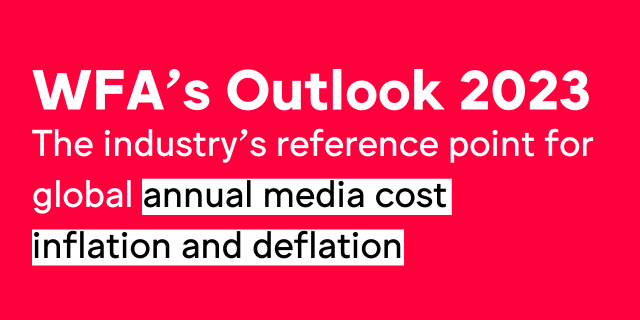Get analysis, insight & opinions from the world's top marketers.
Sign up to our newsletter.
WFA Outlook 2023 reveals the highs and lows of media prices across key markets around the world.

Media price inflation is tracking general inflation in markets, with traditional broadcast TV leading the way at the start of 2023, according to the latest edition of Outlook, the industry’s only consolidated view on media price inflation and deflation.
In 2022 and 2023 media inflation has been close to general price inflation in most countries, and frequently below it. In fact, with the exception of traditional broadcast TV, average media inflation has been tracking somewhat below the general inflation.
As of May 2023, the latest estimates suggest mid- to high single-digit inflation across many markets, especially in the key TV and digital media channels. The older established formats such as print, radio and outdoor are recording marginal levels of low single-digit inflation in most markets.
The WFA’s Outlook report covers 39 markets and 15 media channels and is based on forecasts aggregated from across the major media agency and consultant groups including Cortex Media, Dentsu, Ebiquity, Havas, IPG, Omnicom Media Group, Publicis and PWC.
Significant global outliers are again Argentina and Turkey with media inflation at or approaching +100% plus year-on-year, mainly due to local currency instability issues.
European media inflation will be dominated by broadcast TV with a market-weighted inflation in 2023 of around 9%, although this is pulled down somewhat by a relatively low UK forecast of 4%. The DACH markets are far more bullish, reporting 10% plus inflation.
In Asian markets, the media inflation pattern is the same with the key drivers being TV and digital. The weighted average TV inflation of just 5% is heavily influenced by more modest inflation in China and Japan, which contrasts with the higher rates seen in South and Southeast Asian markets as well as Australia and New Zealand.
In Latin America, Argentina is seeing very high inflation across all media types, driven primarily by currency stability issues. Brazil and Mexico have mid-single digit forecasts across most media types while estimates for Colombia are slightly higher. Linear TV ratings continue to erode around the region, reducing the total number of impressions available for advertising, although TV pricing has been moderated by reduced demand as brands look to digital.
The same pattern of relatively high TV inflation balanced with more moderate single digit levels across other media can also been seen in the United States and Canada. The US Upfront levels of inflation are expected at a much lower level than in recent years. This may change if there is an economic upswing before negotiations are completed.
WFA Member? Download the full Outlook report.
Want to find out more? Attend our webinar on Wednesday July 12 with Mark Gallagher, Executive Vice President, Global Investment at Omnicom Media Group and one of the contributors to Outlook. He will provide a detailed account of how the global media market is expected to evolve in the coming months and years.